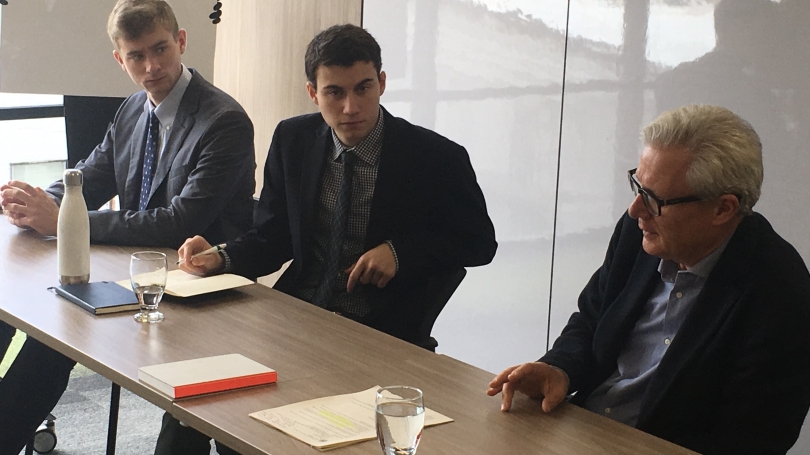
- Public Policy
- Leadership
- Funding
- News & Events
- About the Center
Back to Top Nav
Back to Top Nav
Back to Top Nav
Back to Top Nav
Wednesday in Colombia was incredibly busy, filled with protesting students, gold, and Nutella-strawberry pizza.
To start, the group traveled to the headquarters of the International Committee for the Red Cross. We met with Christoph Harnisch, head of the Colombia delegation to the International Commission of the Red Cross. He provided great insight on Red Cross operations in Colombia, issues of trust among the FARC, the state, and international actors, and what NGOs can do to aid the peace process.
With our next meeting not until 6pm, we took advantage of our free time to enjoy the (temporary) sunshine in Bogota. Many of us went straight to Plaza de Bolivar; nationwide protests against the government were planned, and we expected the Plaza to be a hotspot of activity. Just as we arrived, a parade of hundreds of chanting Colombians slowly entered the square. Protective black netting had been draped down the walls of important buildings surrounding the square, and dozens of National Police with riot shields watched from the perimeter. Also present were several llamas and stray dogs eager to eat the scraps of Billy’s lunch. Despite their cuteness, they did not get any food.
The National Strike included students, educators, union workers, and others protesting inadequate government funding and raising other concerns about the Duque administration.
We then grabbed lunch and headed to museums. Some headed to the Gold Museum, one of the most popular attractions in the city which includes dozens of gold artifacts from various points in Colombian history. Others visited the Casa de Moneda and Museo de Botero, a sprawling complex displaying both history of coinage in Colombia and the art of Fernando Botero. Botero is perhaps the most famous Colombian artist and donated all of his works on display. All museums provided great cover from pouring rain, which turned the sloped streets of Bogota into urban rivers.
After quick naps and coffee stops, we boarded the bus and headed to the offices of Arcadia Magazine, a cultural publication in the city. There, the general director Camilo Andres Jimenez Santofimio, discussed the role of media in the peace process; moreover, we learned about perceptions of the United States and the cultural and political divides within Colombia. Camilo was joined by two colleagues who also shared their insights.
The group left the Arcadia offices and immediately met Mauricio Artiñano at his home nearby. Mauricio is the Special Assistant to the Special Representative of the United Nations Secretary-General to Colombia. He and his friend Kyle, who works at the International Crisis Group, answered our questions for over two hours over Colombian pizza, sodas, and a dessert of Nutella and strawberries. Mauricio recently visited the demobilization camps we will see this upcoming weekend and eagerly told us about what to expect. He and Kyle discussed in depth their views on FARC reintegration, the role of the private sector, and how the FARC peace process could impact future negotiations with the National Liberation Army (ELN). Kyle even shared the disturbing production process of cocaine; spoiler alert, it involves concrete, gasoline, and battery acid. Don’t do it.
All in all, Wednesday’s meetings brought us more valuable information to inform our final white paper and answered many of our most burning questions. We are all looking forward to the next few days we have in Bogota, and to venturing out to the rest of Colombia as we think critically about how the United States can positively impact the implementation of the peace process.
Written by Mark Daniels '19, 18F PBPL 85: Global Policy Leadership course participant
This is part of a series where PBPL 85:Global Policy Leadership students reflect on their experiences during the two-week field research portion of course. While in country, students meet with local policy leaders: politicians, academics, civil society leaders, journalists, business leaders, diplomats, and other in-country experts who help inform their analyses.